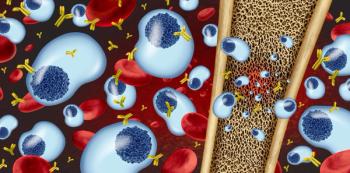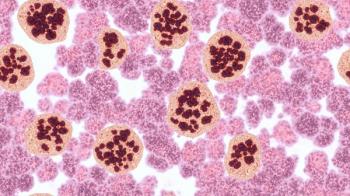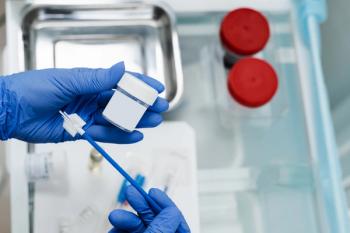
Immunization and Vigilance: Preventing Infections in T-Cell Modifying Therapies
Key Takeaways
- T-cell-modifying therapies have revolutionized hematologic malignancy treatment but introduce unique infection risks requiring vigilant management.
- Early complications like cytokine release syndrome and neurotoxicity can obscure infection signs, necessitating infectious disease consultation.
When administering T-cell–modifying therapies, infections during and after treatment are a serious and pertinent risk.
The introduction of T-cell–modifying therapies, such as chimeric antigen receptor (CAR) T-cell therapy (CAR T) and bispecific antibodies (BsAbs), has shifted the treatment paradigm for hematologic malignancies, vastly improving patient outcomes. With these treatments have come different infection risks, necessitating prompt diagnosis, prophylaxis, and prevention strategies, according to experts at IDWeek 2025 in Atlanta, Georgia.1
Experts presenting at the T-Cell Modifying Therapies: What the ID Provider Needs to Know symposium explained the basics of T-cell–modifying therapies in hematology and oncology patients, identified infections in patients receiving CAR T-cell therapy and BsAbs, and defined preventive strategies—including vaccination and antimicrobial prophylaxis—for patients receiving such therapies.1
What Are the Infection Risks of CAR T and BsAbs?
Before elucidating the specific infection risks of different CAR-T and BsAbs, Susan Seo, MD, FACP, FIDSA, professor of clinical medicine at Weill Cornell Medical College, provided an overview of the patient journey when using CAR T and BsAb therapies. She emphasized the broad efficacy of these new treatments, noting that they have “revolutionized the treatment of hematologic malignancies.” Still, these treatments may lead to both early and late complications.1
One of the most frequent early complications is cytokine release syndrome, which can occur within days of the infusion. Its presentation varies from mild flu-like symptoms to severe systemic inflammation. Neurotoxicity can occur in both CAR T and BsAb therapies, and can present as confusion, aphasia, tremors, or seizures. Seo made an important note that initial management of these complications could mask the signs or symptoms of infection, making infectious disease consultation critical.1
It is later in CAR T or BsAb treatment cycles that infections can occur. Numerous patient characteristics put them at risk for infection, including the underlying malignancy, prior lines of therapy, preexisting cytopenias, age, functional status, and comorbidities. Tools such as the CAR-HEMATOTOX score can help predict complications, using baseline features like platelet count, ferritin, and hemoglobin. However, Seo cautions that, above all, vigilance is key to “early recognition and prompt management.”1-3
How to Determine the Incidence, Timing, and Type of Infection
With so many products now available in the CAR T and BsAbs space, elucidating the various infection types, their prevalence, and timing is critical to prompt and effective treatment. Jessica Little, MD, a transplant infectious diseases physician at Brigham and Women’s Hospital, sought to provide an overview of the general epidemiology and infection prevention strategies of CAR T and BsAbs, stating that “not all CARs and Abs are created equal.”1
She began with CAR T, noting that infections are the leading cause of nonrelapse mortality following therapy. Although research affirms this point, Little noted numerous challenges in accurately assessing patient infections, including inconsistent reporting and definitions, limited information on prophylaxis use, and small cohorts in real-world studies. Critically, Little explained how infection epidemiology can differ based on CAR T-cell targets. Bacteria, viruses, and fungi are pertinent risks, but infections can also fall under the “not otherwise specified” category, complicating treatment efforts.1,4
"It's a huge problem if we don't know the specific infectious pathogens that are killing our patients,” Little said.1
Respiratory infections pose a significant problem after CAR T treatment, with infection frequency increasing post therapy over time. Little and fellow researchers conducted a study to characterize these impacts in a cohort of CAR T recipients. In their trial, 31% of infections occurred between days 0 and 100, while 77% occurred between days 101 and 365. Little advocated for consistent monitoring and follow-up after administration of CAR T therapy, a role that pharmacists are primed to play.1,5
In BsAb treatment, the respiratory tract remains the most common infection site. In patients with multiple myeloma or B-cell lymphoma—2 disease states for which there has been an explosion of BsAbs in recent years—viral-associated mortality has a major impact. Furthermore, opportunistic infections present as “uninvited guests,” according to Little, and are often reported in the form of cytomegalovirus or fungal infections.1
For both BsAbs and CAR T therapies, antivirals are a first-line treatment option. In CAR T treatment specifically, viral prophylaxis is recommended, with many centers using CD4 counts to determine the duration of treatment. Little cautioned against the use of antimicrobials, explaining how the field is beginning to reevaluate their place in the treatment paradigm and possible impacts on patients’ microbiome and their outcomes. Ultimately, a patient’s condition, prior treatment history, and comorbidities will determine how a patient with an infection is treated.1
How Can Infections Be Prevented?
There is a clear risk of infections during CAR T or BsAb therapy, and although treatments for these infections are available, they risk complicating the original course of therapy and possibly worsening patient outcomes. Therefore, there is a need to prevent these infections before they occur at all. Benjamin Teh, MD, faculty at Peter MacCallum Cancer Centre, outlined preventive strategies for infections in CAR T or BsAb recipients, with a major focus on passive and active immunization.1
Critically, 30% of infections in this patient population are preventable, according to Teh. However, vaccination responses post therapy are often low; Teh cited research demonstrating that pneumococcal and influenza vaccines yield response rates of about 30% to 33%, vastly lower than their effectiveness in the real world. In the absence of passive immunization, active immunization using immunoglobulin replacement could result in reductions of rates in all grade infection, infection severity, and mortality.1,6
For traditional vaccination, Teh outlined a series of factors typically associated with higher vaccine responses. These include vaccination prior to receiving CAR T, higher immunoglobulin A levels, and higher B-cell counts. For BsAbs, Teh explained that vaccine responses are often dependent on the antigen target and pathogen. He recommended a tailored, response-guided schedule for individuals, with a focus on respiratory pathogens and the inclusion of booster doses.1
Pharmacists have grown their immunization administration capacity since the COVID-19 pandemic and are well-positioned to act as advocates and counselors for vaccination in T-cell therapy recipients. Trusted in their community and possessing a wide range of expertise in respiratory diseases, pharmacists can inform patients receiving CAR T or BsAb therapies on the benefits of vaccination and work with them on an appropriate immunization schedule for their care.1
REFERENCES
1. Akova M, Hill JA, Teh B, Little J, Seo S. T-cell modifying therapies: what the ID provider needs to know. Presented at: Infectious Disease Week 2025; October 22, 2025; Atlanta, GA. Accessed October 22, 2025.
2. Avutu V, Algazaq JN, Seier K, et al. Infections in patients with solid tumors undergoing adoptive cellular therapy. Transplant Cell Ther. Published online February 22, 2025. doi:10.1016/j.jtct.2025.02.017
3. Nair MS, Silbert SK, Rejeski K, et al. Development of ALL-Hematotox: predicting post-CAR T-cell hematotoxicity in B-cell acute lymphoblastic leukemia. Blood. 2025;145(11):1136-1148. doi:10.1182/blood.2024025910
4. Cordas Dos Santos DM, Tix T, Shouval R, et al. A systematic review and meta-analysis of nonrelapse mortality after CAR T cell therapy. Nat Med. 2024;30(9):2667-2678. doi:10.1038/s41591-024-03084-6
5. Little JS, Tandon M, Hong JS, et al. Respiratory infections predominate after day 100 following B-cell maturation antigen–directed CAR T-cell therapy. Blood Adv. 2023;7(18):5485-5495. doi:10.1182/bloodadvances.2023010524
6. Walti CS, Krantz EM, Maalouf J, et al. Antibodies against vaccine-preventable infections after CAR-T cell therapy for B cell malignancies. JCI Insight. 2021;6(11):e146743. doi:10.1172/jci.insight.146743
Newsletter
Stay informed on drug updates, treatment guidelines, and pharmacy practice trends—subscribe to Pharmacy Times for weekly clinical insights.



















































































































































































































